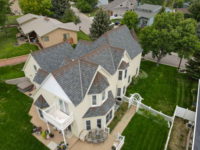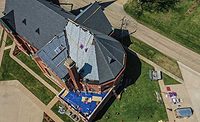Dynamic Dome: Wedge Roofing Earns ARMA Award for Sonoma Dome Project
Northern California roofing contractor takes geodesic dome roofing to a new level.

The complex reroofing of this geodesic domed home in Sonoma Valley, California, earned a Silver Award in the inaugural Excellence in Asphalt Roofing Awards Program, presented by ARMA. Photo by Gary Harvey, of Wedge Roofing.

Wedge Roofing Founder Ralph Wedge (left) accepts a check from Reed Hitchcock, ARMA’s executive vice president, for winning the organization’s 2019 Silver Award at the International Roofing Expo in Nashville. Wedge donated the funds to wildfire relief efforts in northern California. Photo courtesy of ARMA.


It’s the type of roofing project that could make the head of any typical estimator or operations leader spin.
Just the sheer numbers involved alone — 79 individual, triangular-shaped roof decks that make up more than 800 lineal feet of hip and ridge connections with adjacent tie-ins. And crews needed to expertly install it while finding footing on a curved surface multiple stories above the ground.
They’re called geodesic domes, and they’re often famous for their odd beauty, more so than their use of triangular shapes to distribute stress across an entire structure, which makes them able to withstand heavy loads for their physical building footprint.
Though non-traditional, these domes have their root in American architecture beginning in the 1950s, and flourished in certain markets during the 1970s. They’re still prevalent in places such as northern California, where Gary Harvey and his team at Wedge Roofing has developed a bit of a specialty in these challenging roof systems over the years.
“Out of the 18-20 geodesic domes in our geographic region, Wedge has been involved in the replacement or repair on at least half of them. The building owners come to us as a dome specialist,” said Harvey, the general manager at the Petaluma-based commercial and residential roofing company.
Their experience and commitment to installing high-quality roofing products with efficiency and great customer care paid off this year with what’s called the Sonoma Dome project. For its execution, Wedge earned the Silver Award in the first annual Excellence in Asphalt Roofing Awards Program, presented by the Asphalt Roofing Manufacturers Association (ARMA).
Formerly known as the QARC Awards, this annual program recognizes the most versatile, durable and eye-catching asphalt roofing installations across North America. A panel of judges from within the roofing industry selected it from 45 nominations to be among the best to exemplify asphalt roofing’s versatility and ability to provide solutions for complex architectural challenges.
“It’s more apparent every year that professionals can use asphalt to solve nearly any roofing challenge,” said Reed Hitchcock, ARMA’s executive vice president. “The reasons why asphalt roofing is chosen are diverse and dynamic, yet the benefits remain constant: endurance, lifecycle value and reliability, among many more.”
Through the Fire
Since starting the company in 1976, Ralph Wedge has worked through his share of wildfires and other natural disasters. However, the past two wildfire seasons presented major obstacles. Challenges that helped the company grow in multiple ways and set the stage for the award-winning dome project.
The popular vacation spot is nestled in the lush Sonoma Valley, which was the epicenter of the devastating Nuns Fire of 2017. The property itself is unique and eccentric in a way that even northern Californians can appreciate. It offers picturesque views of the valley from high atop a 10-acre parcel. Those are among the biggest reasons it’s highly-sought after rental property in the wine region.
The house stood barely a quarter-mile from where the voracious flames were beaten back and defeated, yet the domed home wasn’t without scars. Flying embers and heat caused incidental damage to the existing three-tab asphalt shingle roof — which was slated for replacement within the next three years prior to the wildfires.
As the ‘go-to’ Bay Area roofing company for geodesic dome roofing, Wedge’s team understands these complex multifaceted structures and has several crews with experience installing them. Harvey said they knew they would have to install new asphalt shingles and multiple modified bitumen layers to help protect against flying debris spewed by future fires.
Picking a system and corresponding material was a virtual no-brainer for the GAF Master Elite contractors. Aesthetics and colors were important to the owner and they ultimately selected a hickory color.
“We’ve done these projects before in wood and that requires a skilled applicator that’s difficult to find these days,” Wedge said. “We would recommend asphalt shingles simply due to the ease of installation and ability to train crews. The cost associated with the labor or materials would double or even triple the cost of the roof.”
Pride Project
While budget conscious — the roof was completed for $75,000 — the real payoff for the crews involved in the installation was its uniqueness.
“It’s a bit of a treat for them to do from time to time because of the challenge,” Harvey said of Wedge’s crewmembers. “It becomes a notable project, not just for the company, but for them personally. This particular one went to a crew that hadn’t done one in a few years.”
With 79 individual triangular decks that almost all interact with another triangle, the potential for waste was tremendous. Estimating correctly was key to the project’s success, so Harvey said they calculated the size of the decks, multiplied by the number of triangles panels needed, and kept a robust collection of excess shingles to cover the overlaps over all three sides of each panel. Crews backed up their calculations with drones and aerial imagery, a tool Wedge Roofing implemented into their operations more than six years ago.
The company also keeps an extensive database of facts and figures of these types of jobs. “From our records of materials used, we can check our numbers with reality and are able to adjust our numbers with the reality factors,” Wedge said.
In all, the project came in just under 3,000 square feet, and needed about 4,300 square feet of roofing material. That’s a waste factor of nearly 45 percent, Harvey said. To put that into perspective, on a typical 3,000 square foot residential roofing project, Wedge crews would expect roughly no more than 3-6 percent waste. Harvey also said Wedge’s crews would typically complete that kind of residential job in one day, where the Sonoma Dome required six crew days, or roughly 400 work hours.
“A lot of times where other companies fail on this type of structure is bidding it too low on the material and labor side because of that tremendous amount of overlapping and waste between triangles,” Harvey explained.
Crews also added a layer of additional waterproofing underneath the decks to ensure the roof system’s durability over time.
Given that every day without an occupant was revenue lost, Wedge agreed to complete the job within a seven-day window. And they actually got it done with a day to spare.
“Getting it done right and getting it done in the allotted timeframe was important,” Harvey said.
Just as important, Wedge said, was giving back to the community in need. The company provided funds and was able to provide direct assistance to those affected by the 2017 wildfires through the use of their trucks for supplies because the flames were literally in their backyards, in some cases. Last season was different since the fires were primarily far to the south. However, Wedge said they donated ARMA’s $1,000 prize money to the North Valley Community Foundation Camp Fire Relief Fund, which provides support to evacuees and fire survivors. Standard Industries, GAF’s parent company, agreed to match that donation during an awards presentation on the show floor at the 2019 International Roofing Expo in Nashville, Tenn.
For more information about this year’s winners or to submit your best asphalt roofing project for the 2020 awards program, visit www.asphaltroofing.org.
Looking for a reprint of this article?
From high-res PDFs to custom plaques, order your copy today!








